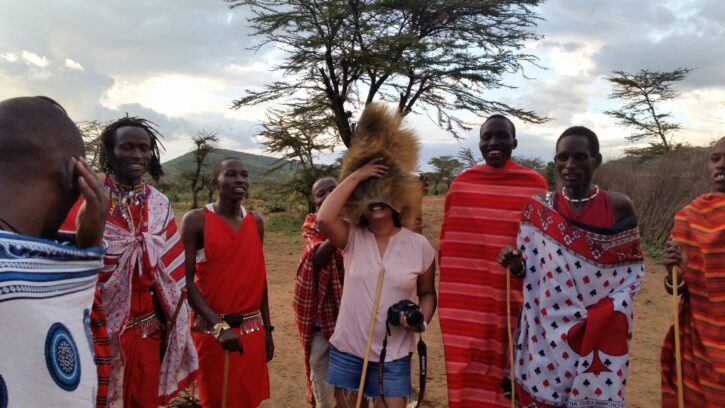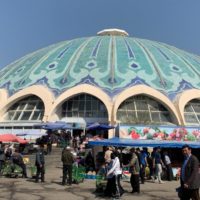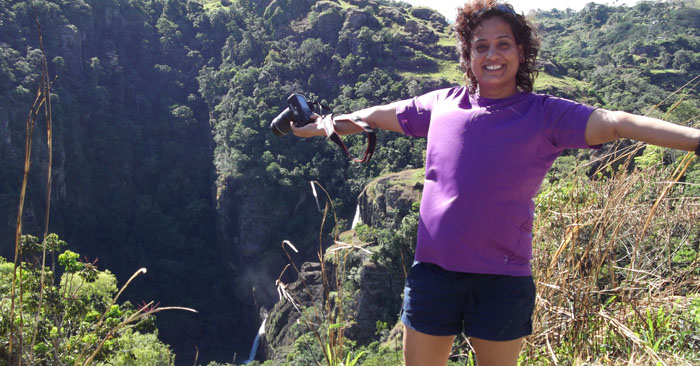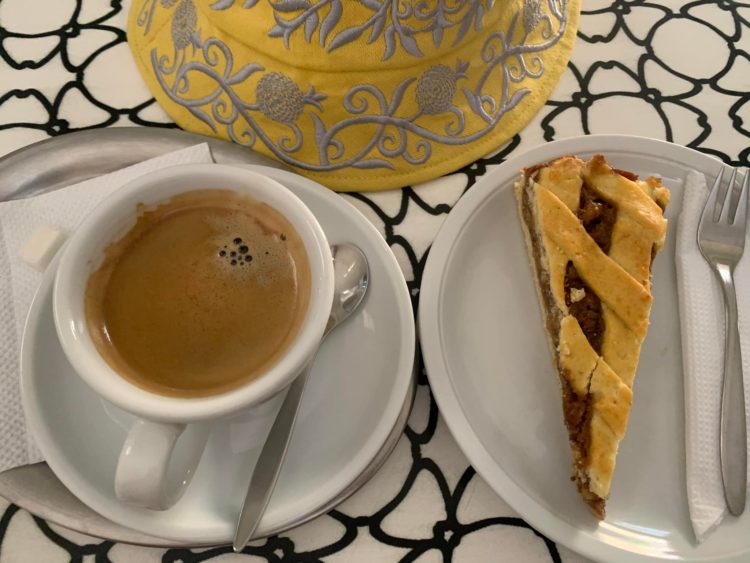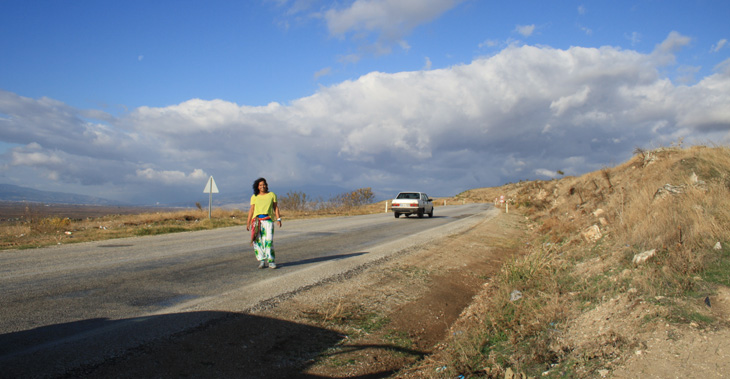The exhilarating game drive came was coming to an end. The day had been very satisfying. My small group of people was among the lucky ones to have seen the Big 5 in Kenya’s famous Maasai Mara or simply, Mara.
It was the real ‘Lion King’ moment. What fun it would be to live – among the lions and the tall Maasai people. Live off the land, so to speak. Surely, there were other women before me who felt the same on being out in the Great African Wild. Who was that woman? Corinne Hoffman! A feisty woman who married a Maasai warrior named Lketinga and later wrote a book The White Masai, which now stands on my shelf.
I saw hope.
A ceremonial wedding
Back at the Rhino Tented Camp, the manager came to me with a suggestion. Judy, a robust young woman with corn rows explained to me how it would do me good to interact with the Maasai people who lived in a village on the fringes of the national park.
Judy and I had fast become friends. “They are very friendly. And handsome,” she added with a wink. I believed her. I had seen some evidence of their agility and strength earlier and was quite curious to know them closely.
When the game drive was about to end, little did I know that my life was going to change in a way I’d never imagined – even if for a short while.
As per her advice, at the crack of dawn I took a leisurely stroll down to the village in the hope of finding myself a Maasai warrior. “You can see and interact with them very closely,” she had told me. “They might even consider you for a bride.”
I entered the village that was bustling with morning activities. I marveled at the small round houses that were set inside an enkang (fence) built by men to protect cattle from the wild animals lurking outside. Some tall, elegant Maasai women in colourful kangas and pierced and stretched earlobes, walked barefoot with children in tow. There were far too many flies though and I swear I saw flies crawl into ears, eye and noses of kids who played continued quite unconcerned. The village elders herded cattle around, lining them up before driving them out of the fence into the wild where it would feed the entire day before bringing them back home.
Suddenly a bunch of young Maasai men clad in bright red shuka appeared out of nowhere and started walking behind me. The women laughed. One of the men spoke up – in very good English too – offering me a cow in exchange for my watch. Business as usual in the Maasai Village.
.
Just then, HE appeared. I stared. This new arrival walked towards me with me with a very stately gait, eyes fixed on me and extended a hand.
“I am Alex,” he intoned deeply. “I am the village headman’s son.”
Suddenly my thoughts went back to Lketinga, the husband of Corinne Hoffman. Did she feel the same on seeing him for the first time?
Alex was taller than the other, very thin and wiry, his cheeks sunken but his eyes shone. Even in that drab early morning, he was alive.
He stood close to me as though I was his possession and began asking questions.
“Mzungu, you come alone. You are married?”
I told him. He smiled. And what a beautiful smile he had.
“You want to marry Maasai way? I will marry you.”
With excitement building inside me, I left for my Day 2 of game drive. We set a time for the “wedding”. It was to take place in the evening when all the tourists returned from their game drive.
The evening ceremony
I returned to the village ready to take the plunge. The village was filled with tourists looking to end the day by immersing themselves in local custom and flavor. Word had got around that there was a wedding to take place between Mzungu and Maasai. (Mzungu is the local word for foreigner).
Soon the dancing started. The olaranyani (song leader) sang the melody in a call and response pattern. It was a dance of courtship between males and females. There was more dancing as we witnessed an adumu, a competitive jumping dance by the warriors. The tall Maasais jumped up and down, never letting their heels touch the ground. Whoever jumped the highest got the warrior status and the option of choosing the prettiest bride. This is one of the traditions followed by the Maasai people of East Africa. Just then Alex slipped into the centre and began to jump. I had a feeling it was “fixed” – because it was decided it was to be his wedding today! He was going to claim me for his bride.
The tourists hooted and clapped. Alex, the winner, took my hand, bowed over it and said –
“Will you marry me?”
I nodded. This was so much fun. Then he led me into his circular home, grinning widely and offered me a bowl of ugali (cornmeal porridge), a pre-wedding supper.
“Ashe,” I said. It was the only word I knew in Maa language. It meant thank you. He then proceeded to dress me up in a kanga (in a real wedding, the village elder dresses the bride) that barely covered my bare legs and pulled down a lion head from the wall.
“Is that real?” I asked him.
“Yes. The lion kill my cow, I kill lion.”
It was that simple. The size of the machete on the wall, the determination on his face and the presence of the lion head itself supported his statement. So, my groom- to- be did have a temper after all! I tried not to think of what would happen if I called off the mock wedding. Would my head hand in the centre of the village?
We walked out of the dark hut and into the evening light, carrying the lion head, ready for the ceremony.
An evening well spent
I didn’t look at all like a bride, except for the kanga half hiding my bare legs. I didn’t look ready for a life with a Maasai warrior, but for the sake of an experience, I was ready to sacrifice my single status to be a Maasai bride even for one night.
Tourists and the villagers formed a semi –circle around us. Alex called out something in Maa language and drums started to roll. I couldn’t tell if it was authentic but if definitely created an atmosphere for fun and excitement.
I was all smiles. Of all the experiences I have had on my travels, never had I come so close to a wedding in the great African wild. What a lot of stories I could tell people. And as cameras started to click, he put the lion head on my head and bowed respectfully.
I wasn’t sure if that concluded the ceremony. Had I just become his wife? What was I supposed to with the lion head? Was it going against their tradition if I took off the uncomfortable lion head that kept slipping down and covering my face? Come to think of it, it was a large lion head too. What a big animal it must have been. Between laughter, posing for camera and wondering what was coming next, I tried to hold my head straight so my “crown” would stay intact.
And then Alex put his arms around me possessively. My heart sank – was this wedding real? Was he expecting me to spend my conjugal night with him or worse, my entire life? The prospect of living in the Savannahs suddenly vanished. If I had to be wed, I’d rather it be my groom carrying me down the aisle in a white wedding gown…here, like this my romantic heart sank to my knees. What did I get myself to?
Would I be committing a Maasai crime if I refused to spend the night in his hut?
In the crowd I spotted the camp manager. I walked towards her with a question concerning my wedding night. She laughed heartily and patted me on my back. Then she looked me up and down, winked and said something that made my fears vanish.
“If you do, you won’t regret it. Maasai men are very big and strong. Maybe you should.” She laughed again. Alex who had arrived just then put his arms around me and held me tightly. Had he heard what she’d said?
Oh, his hug felt so good…
“Come, I show you how to make fire with sticks,” he said, leading me away. I handed him back the lion head, glad to free my head of a weight and leather. “In the morning you make fire like this.”
“Oh, I am not quite sure if that is something I could do, husband,” I relied in jest. I was nervous alright. In the village square (basically the square was a tree) curious tourists were gathered around two young Maasai vigourously rubbing sticks. Their hands tough and calloused rubbed and rubbed but the fire wouldn’t just start. As we approached, the young men stood up and hand the “drilling” stick to me. Alex laughed.
Not the one to resist a challenge, I knelt down and …..
“Oh come on husband, help me here.”
Alex, the village headman’s son, the new husband to a wandering mzungu and the most desired man in that village whipped out a lighter.
“Come, we make a fire faster with this.”
The entire village erupted in laughter. LaterAs I was leaving the village, each one who passed by me whispered a single word. Ashe.
In Maa language, that means Thank You.
Quick facts to remember
A visit to the Maasai village will set you back 1000 Kenyan Shillings (KSH) or about 15 USD. This way you can take as many pictures as you like, be invited into their home, touch their cows, watch them make fire and dance with them. Ceremonial weddings such as mine costs extra.
-Cattle is prized
The life of Maasai people revolves around their cattle. These are given priority above everything else. In every Masaai village, the cattle stay in the centre. This way, they can be watched easily. The cattle are used to trade, to settle scores and as dowry. In other words, it is considered Holy Wealth.
-The Maasai House
The houses are circular and made largely of cow dung and mud. Electricity or running water is not available. The houses are low and poorly lit, and barely furnished. The house consists of one central room, which is also the kitchen. On either sides of the kitchen are beds. One is reserved for the elders and the others for the husband, wife and kids.
-Who are the Maasai people
The Maasai people (people who speak the Maa language) are semi-nomadic and found in Eastern Africa – namely Kenya and Tanzania. They are largely a patriarchal society. They have a very distinct sense of dressing – bright red checkered shawls (called Shuka) worn by men and a colourful fabric called Kanga worn by women. Very few kids go to school although there have been government initiatives to educate them. They are considered one of the tallest people in the world with average height of 6 ft 3 inches according to some reports.
Traditionally, the Maasai diet consisted of raw meat, raw milk, and raw blood from cattle. Today their kitchen is stocked with chips and soda!
A word of caution
- When interacting with the Maasai people, do not show them or their cattle down. Cattle is very sacred to them and dirt is pretty much a part of their everyday lives. Take them as they are.
- Do not “sneak” pictures of them. Pay the required price. Thumb rule – they have a right to refuse pictures. If you can spend a few hundred or thousands of dollars just getting to their home, don’t cringe over spending a few dollars for their pictures.
- Backpacking to the Mara Reserve might not be a great idea. Masaai Mara is about 350 kms away from Nairobi. Black-top roads end after 200kms and there on it is dirt road all the way. All you see here, traveling these roads are determined safari cars (generally modified matatus), few private safari jeeps and very few private cars.
- Hitching or thumbing a ride is NOT a possibility.
A few years later, I visited Alex. He remembered that evening, he said. “My beautiful bride is back. Give me a mobile phone, he said. “I will call you.”

